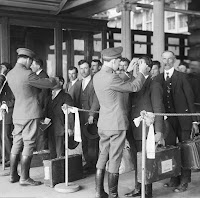Uncertain Health in
an Insecure World – 78
“The Prisoner”
A British TV show of this name starred Patrick McGoohan as former
secret agent, Number Six. Over just 17 episodes in 1968, the show previewed the modern
Netflix and HBO miniseries genre. It was shot with a feature film feel and Orwellian
sensibility.
After being gassed into unconsciousness in his flat, Number
Six finds himself trapped in The Village, where he repeatedly confronts surreal
situations set amid psychological threats, science fictional events and
allegorical themes. Escape attempts are thwarted by a sinister balloon called Rover, controlled by Number Two. Rover is programmed
to prevent general unruliness among the populace and to restrict Number Six's personal egress.
Shot at a secret location in a seaside community (later revealed
as Portmeirion, Wales), the show’s writers followed the old adage, “Be witty, be brief, and be gone.” In the
final episode, Fallout, the combined
effects of hallucinogens, mind control, dream manipulation, and social
indoctrination – psychological warfare and spy craft – took their toll on
Number Six (below). The final twenty minutes of Fallout
baffled inveterate viewers to the point where McGoohan had to go into hiding. Critics
nominated the episode for a sci-fi Hugo Award (1969), and it won a Prometheus
Award (2002).
Solitary confinement is socially accepted as an extreme form
of personal segregation.
Typically, prisoners in solitary confinement spend 23 hours of every day
without any human contact, usually in a cell smaller than a horse stable. For
much of the 20th century, this punishment lasted days or weeks, but
today, it is not uncommon for inmates in “supermax”
prisons to spend years in solitary. While corrections officials view the
practice as an accepted protocol for general prison population safety, the medical
literature shows that caging a person for months to years takes a heavy individual
mental and physical toll.
In the 1950’s, University of Wisconsin psychologist Harry
Harlow placed lone rhesus monkeys in a chamber nick-named “the pit of despair.” Its slippery sides made it impossible to climb
out. After a day or so, the monkeys retreated into a corner, sitting hunched
over, apparently hopeless. In time, they rocked, circled, stared and
self-mutilated. “Twelve months of
isolation almost obliterated the animals socially,” observed Harlow. An
infamous 1951 study of McGill graduate students by psychologist Donald Hebb showed
that within seven days, extreme sensory deprivation caused loss of the ability
to think clearly and hallucinations.
Such research is no longer permitted by modern bio-medical ethics.
Studies of prisoners in solitary confinement are practically
and ethically challenging. Prison systems are diverse and unique in many ways,
making multi-institution cross-sectional comparisons difficult. Since the
1980’s Harvard’s Stuart Grassian has reported high rates
of hallucinations, panic attacks, paranoia, poor concentration, impulsivity,
obsessiveness, suicidal ideation and frank psychosis. As much as two-thirds of
inmates in solitary confinement have a pre-existing psychiatric condition. Of interest, some
research shows that such inmates did not worsen in solitary at rates higher
than those without a prior mental illness diagnosis.
The more common outcome is social atrophy - a disabling
anxiety about social interactions.
Since the 1990’s, University of California Santa Cruz psychologist
Craig Haney has carried out studies of multi-year confinement in “The Hole.” His findings correlate
solitary with higher self-mutilation and suicide rates; 63% of all 1995 prison
suicides in the U.S. occurred in solitary lock-up. His experience with
survivors of multi-decade solitary confinement at Pelican Bay State Prison is “shocking, frankly.”
This is Joseph Harmon, after 8 years in solitary at Pelican Bay.
Haney points out that, “So
much of what we do and who we are is rooted in a social context.” His findings are part of a lawsuit, which revealed
that those exposed to such cruelty undergo “social
death.” Social scientists agree that the eventual release of these inmates
back into society renders solitary confinement counterproductive outside of
prison confines.
U.S. Supreme Court Justice Anthony M. Kennedy wrote a 2015
minority opinion on the practice, in response to the California case of Mr.
Hector Ayala, concluding that “near-total
isolation exacts a terrible price.” Barack Obama’s July 2015 visit to an
Oklahoma federal prison (above), the first by a U.S. President, questioned whether, “We really think it makes sense to lock up so
many people alone in tiny cells for 23 hours a day, sometimes for months or
even years at a time.” An increasing number of top U.S. corrections
officials agree.
Human rights groups consider solitary confinement a form of
torture.
In a 2012 survey, twenty of the world’s 25 worst prisons
are located outside of the U.S. But five of the world’s 10 worst prisons were
situated in the U.S.
An acclaimed TV series is the sum of all its episodes, not
just the finale.
A movement is reflected in the acts of its followers, not just
the words of its leader.
Whether in The Village or in a super-max prison, relegation
of a person to a number begins a by-design de-socialization process.
In the end, individualism loses out to collectivism.
We in the Square follow good TV mini-series, and believe in progressive
social movements.
But in doing so, we must guard against such warmth & fuzziness obscuring concern about the plight of one person.
But in doing so, we must guard against such warmth & fuzziness obscuring concern about the plight of one person.






































